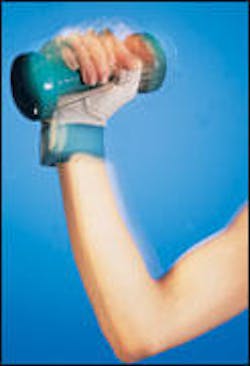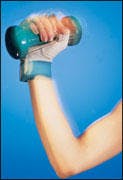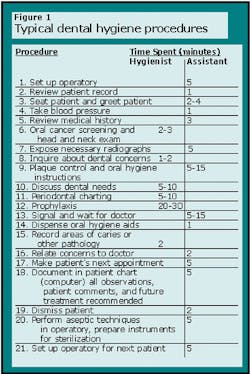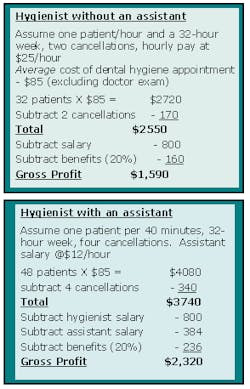A strong right arm
A dedicated hygiene assistant allows the hygienist to focus on improving patient care.
by Dianne D. Glasscoe, RDH, BS
With the passing of time, business models change. The admonition to "work smarter, not harder" should be the goal of every progressive business owner. However, change is difficult for many people. We get in a rut of doing things the way we have always done it, and we are sometimes reluctant to step out of our comfort zone.
Incorporating more efficient work practices is important in keeping the hygiene department profitable. Simply working faster and seeing more patients is not the answer. A traditional "solo" dental hygiene model is inefficient. The hygienist has to spend a large part of the day performing tasks that could be done by an auxiliary. For example, operatory tear down and set up takes about eight minutes per patient. If the hygienist sees an average of eight people per day, operatory turnover alone is one full hour, or one full hour that another patient could be seen.
Many tasks that should be a part of every visit often are omitted because of lack of time. A good example is routine blood-pressure screening. In addition, periodontal probing takes at least twice as long to do without an assistant to record probings. Meaningful conversation about home care procedures and needed dentistry is another area that often goes lacking. Even necessary radiographs are omitted or postponed until the next visit when time is short.
Scheduling inefficiency
The one-hour per patient model of scheduling also is inefficient.While some patients do need a full hour, the fact is that patients are quite variable in their preventive care needs. The patient with immaculate home care does not require the same amount of time as a patient with poor home care. The patient with a partial dentition does not generally require the same amount of time as a patient with a full dentition. Smokers may require more time than nonsmokers.
Children certainly do not require one hour for a prophylaxis and adjunctive services.
A better model would assign time based on the patient's needs. Each patient should be evaluated objectively and scheduled accordingly. After patients become established in the practice, their pattern of home care becomes evident.
When a practice hires a hygiene assistant — but does not change the way hygiene is scheduled — the assistant is not utilized to the fullest. If scheduling is not changed, there will be no increase in production. The assistant only serves to assist in clean-up, developing radiographs, and other menial duties.
Advantages
A much better business model for the hygiene department is to use two operatories and a dedicated assistant. Such a model allows the hygienist to focus on procedures that only a licensed hygienist can do. Other procedures, such as operatory turnover, are assigned to a dedicated assistant. Figure 1 is a list of procedures that take place in a typical dental hygiene appointment and the appropriate personnel to perform each task.
While these times are not absolutes, it is easy to see aspects of the dental hygiene appointment that can be handled by a qualified assistant. This frees the hygienist to move to another operatory and continue seeing patients. The person who benefits the most is the patient, because the quality of care is better when the hygienist can focus on providing quality treatment. Of course, for this model to be workable, two operatories must be available for the hygienist.
The hygienist would work much like many dentists work by rotating between operatories. While the assistant is preparing Operatory 1, the hygienist is in Operatory 2 seeing a patient. The dental assistant would not necessarily have to be in the operatory with the hygienist, but should be available as needed. Times when the assistant would be needed directly with the hygienist would be to record examination findings or periodontal probings, to provide water evacuation during ultrasonic usage, or to provide assistance with sealants.
Hygienists who work with assistants report that doing hygiene procedures is more enjoyable than working solo. Additionally, one of the biggest time-wasters — waiting on the doctor for a hygiene exam — is eliminated. The hygienist can move on to the next patient while the assistant waits with the patient for the doctor.
Disadvantages
The disadvantage of working with a dedicated assistant is evident when the assistant is absent. An assisted schedule is impossible to work without an assistant. Therefore, the schedule must be re-engineered if the assistant is absent and a temporary assistant cannot be located. A written protocol should be established for the dental hygiene assistant that specifies exactly how the operatory is to be set up, exactly what tasks the assistant is responsible for performing, and other pertinent information related to the job. Having a written protocol makes it easier for a new trainee to learn the job.
Another disadvantage is in having an assistant who is not organized and efficient. It is the assistant's responsibility to keep patient flow smooth in the hygiene department and to be available to help the hygienist when needed. You must hire a person who knows what her job expectations are and who shows responsibility in meeting those expectations.
Additionally, the mind-set of the hygienist working with an assistant must be one of teamwork and equality. The hygienist must view this person as her "strong right arm" and treat the assistant with respect ... not as an underling.
The key to working effectively with assisted hygiene is to start slow. Following the hiring and training period, begin integrating with a half day, then a full day. Allow for a learning curve. Do not be deterred if a day falls apart or things do not flow smoothly initially. In dentistry, we are such perfectionists that we often do not give ourselves the time we need to learn or try a new mode of operation.
Careful planning and implementation of the assisted hygiene model can open a whole new world of opportunity. Having a dedicated hygiene assistant allows the hygienist to see more patients, provide better care, and work more efficiently. It is an especially attractive option for areas where shortages of qualified hygienists exist. Patients often perceive a higher level of service when they are not left in the operatory alone. Time with the patient can be used to the fullest by providing more one-on-one contact with members of the dental team. Assisted hygiene is a triple winner for the patient, the hygienist, and the practice!
Dianne D. Glasscoe, RDH, BS, is a professional speaker, writer, and consultant to dental practices across the United States. She is CEO of Professional Dental Management, based in Lexington, N.C. To contact Glasscoe for speaking or consulting, call (336) 472-3515, fax (336) 472-5567, or email [email protected]. Visit her Web site at www.professionaldentalmgmt.com.



